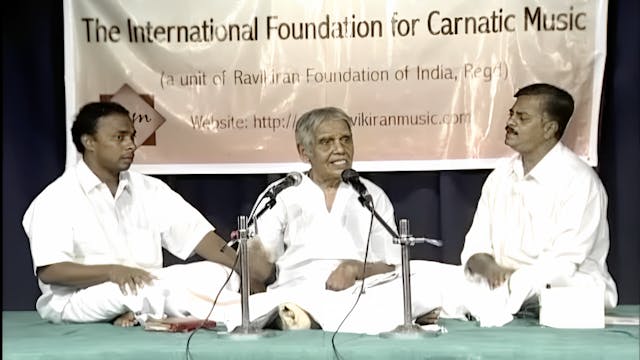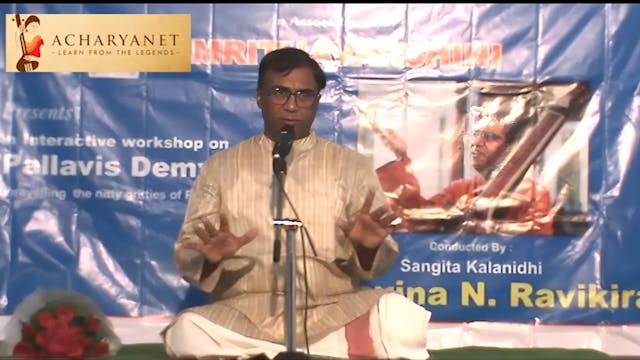-
 44 videos | Rent $29.99 | Buy $199.99
44 videos | Rent $29.99 | Buy $199.99Perfecting Carnatic Music Level 1
44 videos | Rent $29.99 | Buy $199.99
For Indian Residents: To pay with Netbanking, UPI, GPay and other payment options click here.
This is the registration page to become an Acharyanet subscriber to the Perfecting Carnatic Music Level 1 P...
-
 32 videos | Rent $44.99 | Buy $299.99
32 videos | Rent $44.99 | Buy $299.99Perfecting Carnatic Music Level 2
32 videos | Rent $44.99 | Buy $299.99
For Indian Residents: To pay with Netbanking, UPI, GPay and other payment options click here.
This plan gives streaming access to all the lessons from Perfecting Carnatic...
-
SWATI TIRUNAL NAVARATRI KRTIS
9 videos | Rent $63 | Buy $90
Maharaja Swathi Thirunal Rama Varma, popularly known as Swathi Thirunal, was a prolific composer and ruler of the Kingdom of Travancore in South India during the early 19th century. He made significant contributions to both Carnatic and Hindustani classical music traditions. His compositions, whi...
-
NAVARATRI SONGS
9 videos | Rent $30 | Buy $60
Discover a unique collection of famous and rare compositions, expertly curated by Acharyanet, featuring the teachings of legendary gurus. This special selection celebrates the goddesses Parvati, Lakshmi, and Saraswati, allowing you to connect deeply with their divine qualities. Perfect for presen...
-
TAMIL KRTIS OF G N BALASUBRAMANIAN COMPOSITIONS
8 videos | Rent $20 | Buy $45
Learn beautiful Tamil Krtis of Shri G N Balasubramanian taught by Sangita Kalanidhi Neyveli Santhanagopalan, Sangeeta Samrat Chitravina N Ravikiran, Sangita Kalanidhi S Sowmya, Vid. Bhushany Kalyanaraman
Get access to all 8 compositions of Sri G N Balasubramanian taught by stalwarts in this mast... -
OVK'S TAMIL COMPOSITIONS: Shri TN Seshagopalan .
8 videos | Rent $20 | Buy $45
Learn beautiful Tamil Krtis of Shri Oottukkadu Venkata Kavi taught by Sangita Kalanidhi Padmabhushan Shri TN Seshagopalan
Songs taught in the masterclass:
1) Sonnaal ozhiya manam - Kannada - Adi - Oottukkadu Venkata Kavi
2) Raman perumai solla - Nattakurinji - Adi - Oottukkadu Venkata Kavi
3) ... -
RARE KANNADA COMPOSITIONS: Vid. Lakshmi Nagaraj
4 videos | Rent $20 | Buy $45
Masterclass conducted by Renowned Guru Vid. Lakshmi Nagaraj.
Songs taught in the masterclass:
1. Nandatanaya govindana - Yamankalyani - Adi
Lyrics : Purandaradasa
Tuned by: Shri RK Srikantan2. Manave mantralaya - Shudh sarang - Adi
Composer: Sri A V Krishnamachar3. Baa janani - Kada...
-
Geetha Kairali: Dr N J Nandini
4 videos | Rent $20 | Buy $45
Geetha Kairali: Masterclass on Compositions of Kerala Composers taught by Dr NJ Nandini
Songs taught in the masterclass:
1. Shri hare janardana - Revathi - Adi - Pudukkode Krishnamurthy
2.Chenthar sayaka - Behag - Mishra chapu - Irayimman Thampi
3. Shri hariharasutha - Saramathi - Adi - K ... -
THE 3Ps OF SUCCESS: Dr Trichy Sankaran
1 video | Rent $20 | Buy $45
This is an educational masterclass led by the esteemed Mridangam maestro, Prof. Trichy Sankaran. Delve into the intricacies of his journey to mastery as he shares invaluable insights and techniques in his presentation, 'Practice, Perfection, and Presentation'. Explore each facet of his expertise ...
-
SOLLU DEVELOPMENT: Prof Trichy Sankaran
1 video | Rent $34.99 | Buy $49.99
-
 11 videos | Rent $91.99 | Buy $131.99
11 videos | Rent $91.99 | Buy $131.99DIKSHITAR'S KAMALAMBA NAVAVARANAMS
11 videos | Rent $91.99 | Buy $131.99
Muttuswamy Dikshitar, one of the trinity composers of Carnatic music, composed a set of nine compositions known as the "Kamalamba Navavaranams." These compositions are dedicated to the goddess Kamalamba, a form of the divine mother, and are typically sung as part of Navaratri celebrations. The Na...
-
OVK's KAMAKSHI NAVAVARANAMS:Chitravina N Ravikiran
12 videos | Rent $41.99 | Buy $59.99
Oottukkadu Venkata Kavi, a prolific composer in the Carnatic music tradition, is indeed credited with composing a set of nine compositions known as "Kamakshi Navavarnams." These compositions are dedicated to the goddess Kamakshi, a form of the divine mother, and are sung in praise of her during N...
-
DIKSHITAR'S NAVAGRAHA KRTIS:Chitravina N Ravikiran
10 videos | Rent $76.99 | Buy $109.99
Muthuswami Dikshitar, one of the Trinity composers of Carnatic music, composed a set of nine compositions known as the "Navagraha Kritis," dedicated to the nine celestial bodies or "grahas" in Hindu astrology. Each composition is dedicated to a specific graha and is sung to propitiate the planeta...
-
 14 videos | Buy $100
14 videos | Buy $100OVK's SAPTARATNAS: Chitravina N Ravikiran
14 videos | Buy $100
Sangeet Samrat Chitravina N Ravikiran, a master musician, composer and guru brings his in-depth knowledge and research on the brilliant composer Oottukkadu Venkata Kavi to this course. The Saptaratnas are a selection of 7 masterpieces composed by Oottukkadu Venkata Kavi that are known for their b...
-
TYAGARAJA'S PANCHARATNAMS: Chitravina N Ravikiran
5 videos | Rent $41.99 | Buy $59.99
Tyagaraja, one of the Trinity composers of Carnatic music, composed a set of five compositions known as the "Pancharatna Kritis" (Five Gems). These kritis are considered masterpieces of Carnatic music and are revered for their musical brilliance, lyrical richness, and spiritual depth. They are su...
-
 6 videos | Rent $41.99 | Buy $59.99
6 videos | Rent $41.99 | Buy $59.99COMPOSITIONS OF PURANDARADASA - Part 1
6 videos | Rent $41.99 | Buy $59.99
Purandara Dasa, often referred to as the "Father of Carnatic Music," was a prolific composer, saint, and musician who lived in the 15th century. He played a significant role in shaping the Carnatic music tradition and is credited with laying the foundation for the structured teaching and learning...
-
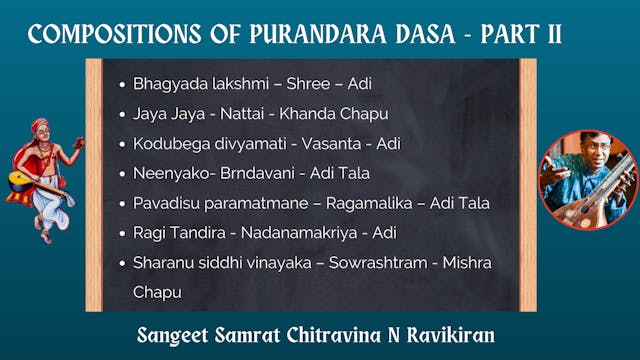 7 videos | Rent $41.99 | Buy $59.99
7 videos | Rent $41.99 | Buy $59.99COMPOSITIONS OF PURANDARADASA - PART 2
7 videos | Rent $41.99 | Buy $59.99
Purandara Dasa, often referred to as the "Father of Carnatic Music," was a prolific composer, saint, and musician who lived in the 15th century. He played a significant role in shaping the Carnatic music tradition and is credited with laying the foundation for the structured teaching and learning...
-
Varnams of TR Subramanyan: Shri Delhi Muthukumar
2 videos | Rent $19.99 | Buy $39.99
Learn the beautiful varnams of Shri T R Subramanyan taught by Delhi Shri Muthukumar.
Varnams in this collection:
Gananatha - Devagandhari - Adi - T R Subramanyan
Dharmamaa - Varamu - Adi - T R SubramanyanFor Indian Residents: To pay with Netbanking, UPI, GPay and other payment options, cl...
-
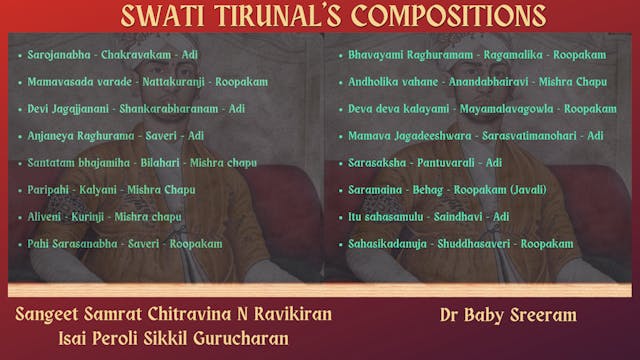 16 videos | Rent $111.99 | Buy $159.99
16 videos | Rent $111.99 | Buy $159.99SWATI TIRUNAL COMPOSITIONS
16 videos | Rent $111.99 | Buy $159.99
Maharaja Swathi Thirunal Rama Varma, popularly known as Swathi Thirunal, was a prolific composer and ruler of the Kingdom of Travancore in South India during the early 19th century. He made significant contributions to both Carnatic and Hindustani classical music traditions. His compositions, whi...
-
 12 videos | Rent $76.99 | Buy $109.99
12 videos | Rent $76.99 | Buy $109.99MODEL RAGA ALAPANAS - PART 1
12 videos | Rent $76.99 | Buy $109.99
Alapana is a melodic exploration of a raga (melodic mode) without the rhythmic accompaniment of percussion instruments, allowing the musician to explore its nuances, emotive potential, and aesthetic beauty. It serves as a means for the performer to establish the mood and essence of the raga, grad...
-
 12 videos | Rent $83.99 | Buy $119.99
12 videos | Rent $83.99 | Buy $119.99MODEL RAGA ALAPANAS - PART 2
12 videos | Rent $83.99 | Buy $119.99
Alapana is a melodic exploration of a raga (melodic mode) without the rhythmic accompaniment of percussion instruments, allowing the musician to explore its nuances, emotive potential, and aesthetic beauty. It serves as a means for the performer to establish the mood and essence of the raga, grad...
-
 11 videos | Rent $24.90 | Buy $39.90
11 videos | Rent $24.90 | Buy $39.90MODEL KALPANA SWARAMS
11 videos | Rent $24.90 | Buy $39.90
Kalpana Swarams are improvised melodic passages sung or played by the performer in Carnatic music. Kalpana Swarams provide the artist with an opportunity to showcase their improvisational skills, creativity, and mastery of rhythm and melody. These improvised sequences of musical notes are sung or...
-
Kannada Compositions: Shri R K Padmanabha
8 videos | Rent $40 | Buy $60
Learn Kannada compositions of Shri Vadiraja and Dr R K Padmanabha. The following compositions have been taught in this course:
1. Enesalennalave - Mohana - Adi - Shrimad Vadiraja
2. Baagilali biddiha - Poorvikalyani - Adi - Shrimad vadiraja
3. Samaganapriye - Hindolam - Adi - Shri R K Padmanabh... -
RHYTHMS IN INDIAN KNOWLEDGE SYSTEMS - PART 1
6 videos | Rent $41.99 | Buy $59.99
Rhythms play a significant role in various Indian knowledge systems, encompassing diverse fields such as music, dance, poetry, literature, spirituality, and even science. Indian classical music and dance traditions, such as Carnatic music, Hindustani music, Bharatanatyam, Kathak, and Odissi, are ...
-
RHYTHMS IN INDIAN KNOWLEDGE SYSTEMS - PART 2
7 videos | Rent $41.99 | Buy $59.99
Rhythms play a significant role in various Indian knowledge systems, encompassing diverse fields such as music, dance, poetry, literature, spirituality, and even science. Indian classical music and dance traditions, such as Carnatic music, Hindustani music, Bharatanatyam, Kathak, and Odissi, are ...
-
 10 videos | Rent $27.99 | Buy $49.99
10 videos | Rent $27.99 | Buy $49.99BHADRACHALA RAMADAS COMPOSITIONS
10 videos | Rent $27.99 | Buy $49.99
Bhadrachala Ramadasa, also known as Kancharla Gopanna, was a 17th-century composer and devotee of Lord Rama. He is revered for his devotional compositions, which are primarily in Telugu and are dedicated to Lord Rama and his consort, Sita. Ramadasa's compositions are characterized by their simpli...
-
 16 videos | Rent $83.99 | Buy $119.99
16 videos | Rent $83.99 | Buy $119.99TILLANAS
16 videos | Rent $83.99 | Buy $119.99
A tillana is a moderately fast-paced rhythm-centric composition performed towards the end of the concert. Tillanas predominantly contain rhythmic syllables called jathis/solkattus set to a melodic framework. Though Tillanas contain lyrics, they typically appear in the last segment of the Tillana ...
-
 11 videos | Rent $76.99 | Buy $109.99
11 videos | Rent $76.99 | Buy $109.99COMPOSITIONS OF MYSORE VASUDEVACHARYA
11 videos | Rent $76.99 | Buy $109.99
Mysore Vasudevacharya was a prolific composer and one of the foremost figures in Carnatic music. His compositions are known for their lyrical beauty, rich melodic content, and adherence to traditional musical structures. He composed numerous krithis in various languages, primarily in Telugu and S...
-
SHASTRI FAMILY KRTIS: Chitravina N Ravikiran
10 videos | Rent $90.99 | Buy $129.99
The Shastri Family Krtis include compositions composed by Shyama Shastri, Subbaraya Shastri and Annasami Shastri. Shyama Shastri, one of the Trinity of Carnatic music along with Tyagaraja and Muthuswami Dikshitar, was a prolific composer known for his devotional compositions in Telugu. His compos...
-
 12 videos | Rent $39 | Buy $59.99
12 videos | Rent $39 | Buy $59.99DEVOTIONAL - PART 1
12 videos | Rent $39 | Buy $59.99
The Bhakti movement, which emerged in medieval India, inspired a rich tradition of devotional literature and music across various regions and languages. Composers and saints belonging to different religious traditions, including Hinduism, Islam, and Sikhism, contributed to this movement by creati...
-
 13 videos | Rent $49 | Buy $69.90
13 videos | Rent $49 | Buy $69.90DEVOTIONAL - PART 3
13 videos | Rent $49 | Buy $69.90
The Bhakti movement, which emerged in medieval India, inspired a rich tradition of devotional literature and music across various regions and languages. Composers and saints belonging to different religious traditions, including Hinduism, Islam, and Sikhism, contributed to this movement by creati...
-
 9 videos | Rent $69.99 | Buy $99.99
9 videos | Rent $69.99 | Buy $99.99108 DIVYA DESHA GAANAAMRTAM- PART 1
9 videos | Rent $69.99 | Buy $99.99
Chitravina N Ravikiran’s 108 Divya Desha Gaanaamrtam (Musical Nectar of 108 Holy Abodes) is a pioneering creation in the history of Indian Culture and Music. This inspired creation consists of 108 individual compositions in 4 languages – Sanskrit, Tamil, Hindi and Telugu. Each of these is dedicat...
-
 5 videos | Rent $69.99 | Buy $99.99
5 videos | Rent $69.99 | Buy $99.99108 DIVYA DESHA GAANAAMRTAM- PART 2
5 videos | Rent $69.99 | Buy $99.99
Chitravina N Ravikiran’s 108 Divya Desha Gaanaamrtam (Musical Nectar of 108 Holy Abodes) is a pioneering creation in the history of Indian Culture and Music. This inspired creation consists of 108 individual compositions in 4 languages – Sanskrit, Tamil, Hindi and Telugu. Each of these is dedicat...
-
 13 videos | Rent $99.99 | Buy $129.99
13 videos | Rent $99.99 | Buy $129.99ANNAMACHARYA COMPOSITIONS
13 videos | Rent $99.99 | Buy $129.99
Annamacharya, also known as Annamayya, was a 15th-century saint-poet and composer who is renowned for his devotional compositions dedicated to Lord Venkateswara, a form of Lord Vishnu. He composed thousands of songs, primarily in Telugu, expressing his deep love and devotion for the deity.
Lear...
-
 6 videos | Rent $34.99 | Buy $49.99
6 videos | Rent $34.99 | Buy $49.99Rare Tamizh Krtis : Sankari Krishnan
6 videos | Rent $34.99 | Buy $49.99
For Indian Residents: To pay with Netbanking, UPI, GPay and other payment options click here.
Learn Rare Tamizh Kritis taught by Smt. Sankari Krishnan in this masterclass. The following song...
-
DASA PADAS: Sangita Kalanidhi R.K. Shrikantan
5 videos | Rent $34.99 | Buy $59.99
Devotional compositions hold a central place in Carnatic music, expressing the profound spirituality and devotion of both composers and performers. These compositions, known as keertanas, are often dedicated to Hindu deities and are sung with a deep sense of bhakti (devotion). Devotional composi...
-
NADA VIDYA MARMAMU: Shri Neyveli Santhanagopalan
1 video | Rent $34.99 | Buy $49.99
Get access to this Masterclass conducted by Sangita Kalanidhi Shri Neyveli Santhanagopalan on valuable tips and insights to master the art of good music performance. The following topics were covered:
Voice culture – Chord practice in various ragas and Jantai varisai practice in various ragas...
-
 4 videos | Rent $34.99 | Buy $49.99
4 videos | Rent $34.99 | Buy $49.99TAMIZH AMUDHAM: Dr K Gayatri
4 videos | Rent $34.99 | Buy $49.99
Learn the following exquisite Tamil compositions taught by Dr K Gayatri during her Tamizh Amudham masterclass for Acharyanet: Notations are provided for all the songs taught.
Sharanam sharanam - Sowrashtram - mishra chapu - arunachala kavirayar
Angaikodu - Ragamalika - Chanda tala - Thayumanavar... -
COMP. OF SUCHINDRAM SUBRAMANIAM: Akkarai Sisters
3 videos | Rent $19.99 | Buy $39.99
Suchindra Sivasubramaniam is a contemporary composer in the Carnatic music tradition, known for his innovative compositions that blend traditional elements with modern influences. While he may not have a vast repertoire like some of the classical masters, Suchindra Sivasubramaniam has contributed...
-
 12 videos | Rent $49.99 | Buy $69.99
12 videos | Rent $49.99 | Buy $69.99TAMIZH ISAI ULA: Sikkil Gurucharan
12 videos | Rent $49.99 | Buy $69.99
Tamizh Songs Taught By Shri Sikkil Gurucharan in this Masterclass are listed below.
- Manadil urudhi vendum – Behag- Subramanya
- Annalin Aanai- Varnam- Kalyanavasantham- Panchapakesa
- Ninnaipedappo - Nadanamakriya - Vedanayagam Pillai
- Yaarukkuthan theriyum – Devamanohari – Gopalakrishna Bhar... -
TALAMATICS - 6 LEVELS by Dr Ghatam Karthick
6 videos | Rent $34.99 | Buy $49.99
Masterclass on Tala and Laya by Dr Ghatam Karthick. This is part of a 6-session course. LEVELS 1-6 are available here. Read a full summary of the session on our blog. The following topics were cove...
-
BHAJANS ON LORD SIVA: Dr Sriram Parasuram
7 videos | Rent $34.99 | Buy $49.99
The Bhakti movement, which emerged in medieval India, inspired a rich tradition of devotional literature and music across various regions and languages. Composers and saints belonging to different religious traditions, including Hinduism, Islam, and Sikhism, contributed to this movement by creati...
-
 8 videos | Rent $34.99 | Buy $49.99
8 videos | Rent $34.99 | Buy $49.99JAVALIS: Smt Rama Ravi
8 videos | Rent $34.99 | Buy $49.99
Javalis are a genre of light classical compositions in Carnatic music, known for their expressive and often romantic lyrical content. Unlike traditional Carnatic compositions like krithis, which focus on devotional themes and are typically sung in concerts, javalis are more suited for semi-classi...
-
COMPOSITIONS OF KERALA COMPOSERS:Prince Rama Varma
2 videos | Rent $9.99 | Buy $19.99
Kerala, known as the land of diverse cultures and rich artistic traditions, has produced several eminent composers whose compositions have enriched the musical heritage of South India. While Kerala's classical music tradition is primarily rooted in Carnatic music, there are also unique regional f...
-
THANJAVUR SHANKARA IYER COMP: Shri Shankara Iyer
6 videos | Rent $19.99 | Buy $29.99
Thanjavur Shankara Iyer (1845–1902) was a renowned composer in the Carnatic music tradition. He was a disciple of the famous composer and musician Patnam Subramania Iyer. Thanjavur Shankara Iyer's compositions are known for their lyrical beauty, melodic richness, and adherence to traditional form...
-
MELA RAGAMALIKA GEETAM: Chitravina N Ravikiran
16 videos | Rent $7.99 | Buy $11.99
The concept of Melaragageetham helps the student in the beginner stages to understand ragas better and how to effortlessley switch between ragas. Sangeet Samrat Chitravina Ravikiran teaches his own composition, the 72 Mela Ragamalika Geetham in this online classroom session. The notation for thi...
-
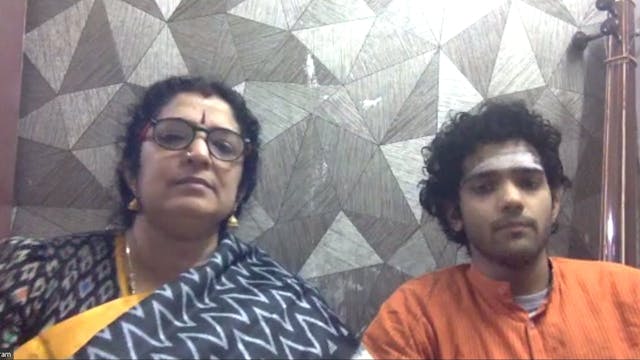 7 videos | Rent $34.99 | Buy $49.99
7 videos | Rent $34.99 | Buy $49.99SWATI TIRUNAL KRTIS: Dr Baby Sriram
7 videos | Rent $34.99 | Buy $49.99
Maharaja Swathi Thirunal Rama Varma, popularly known as Swathi Thirunal, was a prolific composer and ruler of the Kingdom of Travancore in South India during the early 19th century. He made significant contributions to both Carnatic and Hindustani classical music traditions. His compositions, whi...
-
RARE COMPOSITIONS OF TRINITY:Shri PS Narayanaswamy
8 videos | Rent $34.99 | Buy $49.99
Padma Bhushan Shri PS Narayanaswamy teaches rare compositions of Muttuswamy Dikshitar, Tyagaraja and other composers in this masterclass. This empowers students to understand the nuances in rare ragas, understand the key phrases. This purchase enables lifetime access to this content for you to st...
-
NAMASANKEERTANAM: Udaiyalur Dr K Kalyanaraman
2 videos | Rent $34.99 | Buy $49.99
Namasankirtanam is a devotional practice in Hinduism that involves the congregational singing or chanting of the divine names (nama) of God (sankirtana). It is considered one of the most powerful and effective means of attaining spiritual upliftment and liberation (moksha). The form of Congregati...
-
TANAM TECHNIQUES: Dr R S Jayalakshmi
1 video | Rent $19.99 | Buy $39.99
-
Chitravina N Ravikiran’s DASHAVATARA RATNA MALA
10 videos | Rent $70 | Buy $99
Sangeet Samrat Shri Chitravina N Ravikiran composed this set of 10 songs on Vishnu’s 10 incarnations in 4 days in July 2023 during a trip to Seattle, USA (except the one on Buddha which had been composed a few years ago). Besides, he has also composed 2 songs – the Dashavatara Pancha Raga-Bhasha...
-
MIRA BHAJANS AND ABHANGS: Dr Sriram Parasuram
5 videos | Rent $34.99 | Buy $49.99
The Bhakti movement, which emerged in medieval India, inspired a rich tradition of devotional literature and music across various regions and languages. Composers and saints belonging to different religious traditions, including Hinduism, Islam, and Sikhism, contributed to this movement by creati...
-
VIVAHAPRIYA- WEDDING SONGS COLLECTION
8 videos | Rent $70 | Buy $100
Weddings and Festivals are such auspicious events and we must ensure that they reverberate with positive vibrations and music. Acharyanet is proud to present a dazzling multi language Wedding Song Collection performed by a fantastic set of artists, Anahita & Apoorva (Vocal), Mylai Kartikeyan (Nad...
-
RAMANATAKA COMPOSITIONS:Alepey Venkatesan - Part 1
5 videos | Rent $34.99 | Buy $49.99
In this masterclass of Arunachalakavi Rayar's Ramanataka compositions, Vid Alepey Venkatesan teaches several compositions that are set to tune by the doyen Vid Ariyakudi Ramanuja Iyengar.
Compositions taught in this part 1 of the masterclass are:
1.Andarama-Kedaragoula
2.Mannanmudi-Hindolam
3.Yaa... -
RAMANATAKA COMPOSITIONS:Alepey Venkatesan - Part 2
4 videos | Rent $34.99 | Buy $49.99
In this masterclass of Arunachalakavi Rayar's Ramanataka compositions, Vid Alepey Venkatesan teaches several compositions that are set to tune by the doyen Vid Ariyakudi Ramanuja Iyengar.
Compositions taught in this part 2 of the masterclass are:
1.Arendruraghavanai - Yadukulakambhodhi
2. Arivar-... -
RAMAYANA RAGAMALIKAS: Chitravina N Ravikiran
3 videos | Rent $29.99 | Buy $44.99
Ragamalika compositions are a unique form of Carnatic music where multiple ragas are seamlessly woven together within a single composition. Ragamalika compositions often showcase the composer's creativity and mastery over different ragas, while also enhancing the emotional and aesthetic appeal of...
-
TIRUPPUHAZHS: Sangeet Samrat Chitravina Ravikiran
10 videos | Rent $69.99 | Buy $99.99
Tiruppugazh is a form of devotional poetry in Tamil literature composed by the saint-poet Arunagirinathar (15th century). Tiruppugazh literally means "divine praise" or "glory to the Lord." Arunagirinathar composed these verses as a means of expressing his intense devotion to Lord Muruga (also kn...
-
NARAYANA TEERTHA: Shri Malladi Ravikumar
3 videos | Rent $27.99 | Buy $39.99
Narayana Teertha (17th century) was a prominent composer and philosopher in the field of Indian classical music, particularly in the Carnatic tradition. He is best known for his composition called "Krishna Leela Tarangini," a collection of 12 musical operas known as "tarangams," which depict vari...
-
VEENA SHESHANNA's COMPOSITIONS:Dr Manjula Surendra
3 videos | Rent $19.99 | Buy $29.99
Veene Sheshanna (1852–1926) was a legendary musician and one of the foremost exponents of the Saraswati veena, a classical Indian string instrument. His exceptional talent and dedication to music earned him widespread acclaim and established him as a seminal figure in the Carnatic music traditio...
-
"AZHAGE TAMIZHE" by Vid. Sankari Krishnan
5 videos | Rent $27.99 | Buy $39.99
A workshop on Tamil compositions of legendary composers like Gopalakrishna Bharathi, Maarimuttapillai, Arunachala Kavi, Vedanayakam Pillai was conducted by Vidushi Sankari Krishnan. This session gives an insight into various masterpieces in Tamil Literature. Notations are provided for all the son...
-
ALL INDIA RADIO (AIR) Audition Prep Course -Part 1
1 video | Rent $27.99 | Buy $39.99
A new series for those interested to get AIR grading as well as those seeking general proficiency in manodharma.
Acharyanet presents a zoom session with Sangeet Samrat Chitravina N Ravikiran.
Please note that this session has been conducted already on Nov 20th. You can complete the payment to g...
-
ALL INDIA RADIO (AIR) Audition Prep Course -Part 2
2 videos | Rent $27.99 | Buy $39.99
Acharyanet is back with Part 2 of the ongoing series of the All India Radio Audition Prep Course with Sangeet Samrat Vid. Chitravina N Ravikiran.
This session is over and was conducted on 11th December 2021, Saturday at 8.30 PM IST via Zoom. However, you may still register below to get access to...
-
ALL INDIA RADIO (AIR) Audition Prep Course -Part 3
2 videos | Rent $27.99 | Buy $39.99
Acharyanet is back with Part 3 of the ongoing series of the All India Radio Audition Prep Course with Sangeet Samrat Vid. Chitravina N Ravikiran.
This is a series for those interested in AIR grading as well those seeking general proficiency in Manodharma.
The session has already been conducted ...
-
Flute Masterclass by Vid Heramb and Hemanth
3 videos | Buy $80
This is a masterclass in Flute, conducted by Vidwans Heramb and Hemanth.
Highlights of the course:
1. A Kriti with detailed analysis
2. To refine blowing and fingering techniques
3. Balancing the Gayaki approach with the instrumental
4. Sophisticated methods of notating
5. Improvement in knowledg... -
VOICE TECHNIQUES IN MANODHARMA: N Ravikiran
5 videos | Rent $27.99 | Buy $39.99
Access the recording of this masterclass session conducted by Sangeet Samrat Chitravina N Ravikiran on mastering various aspects of manodharma.
The following topics were covered in this session:
Introduction to Voice Culture in Manodharma
Model Raga Alapana with example in Mohanam – Part 1
Mode... -
LAYA SAARAMRTAM: Chitravina N Ravikiran
1 video | Rent $7.99 | Buy $14.99
Sangeeta Siksha Peetam (Convener: Dr. Nanditha Ravi ) conducted the Laya Saaraamrtam Session with Sangeet Samrat Chitravina N Ravikiran on July 15th at Chennai. The recorded session is now available on Acharyanet for the benefit of students.
The following topics were covered in this session:
Gen... -
PALLAVIS DEMYSTIFIED: Chitravina N Ravikiran
1 video | Rent $14.99 | Buy $19.99
Sangeet Samrat Chitravina N Ravikiran conducts a masterclass on understanding Pallavis, an advanced concept in classical music performance, typically part of the ragam tanam pallavi segment featured in a Carnatic concert.
For Indian Residents: To pay with Netbanking, UPI, GPay and other paym...
-
VIVAHAPRIYA: Wedding Songs: Chitravina N Ravikiran
5 videos | Rent $34.99 | Buy $49.99
Get access to thismMasterclass on an equisiste collection of wedding songs taught by Sangeet Samrat Chitravina N Ravikiran. The following songs are included in this masterclass:
Svagatam Krishna – Mohanam – Adi – Oottukkadu Venkata Kavi
Seeta kalyana – Kuranji – Khanda chapu – Thyagaraja
Nagumom... -
VOICE CULTURE IN KEERAVANI: Chitravina N Ravikiran
3 videos | Rent $34.99 | Buy $49.99
-
PRE-TRINITY COMPOSITIONS: Chitravina Ravikiran
5 videos | Rent $34.99 | Buy $49.99
This masterclass was taught by Sangeet Samrat Chitravina N Ravikiran and includes compositions of composers from the pre-trinity era.
Lyrics for the compositions can be found here
The following ...
-
 4 videos | Rent $34.99 | Buy $49.99
4 videos | Rent $34.99 | Buy $49.99ANJANEYA SONGS: Shri Sikkil Gurucharan
4 videos | Rent $34.99 | Buy $49.99
Masterclass by Shri Sikkil Gurucharan on Anjenaya Compositions. The session included the following songs:
Lyrics can be found here.Annalin Aanai- Varnam- Kalyanavasantham- Panchapakes...
-
 4 videos | Rent $34.99 | Buy $49.99
4 videos | Rent $34.99 | Buy $49.99SONGS ON RAMA: Chitravina N Ravikiran
4 videos | Rent $34.99 | Buy $49.99
Get access to this Masterclass by Sangeet Samrat Chitravina N Ravikiran on compositions on Lord RamaThe following songs were taught:
Lyrics to the songs can be found here.Mithiladhipa-...
-
BHAJANA MARGA KRTIS PART 1:Chitravina N Ravikiran
7 videos | Rent $34.99 | Buy $49.99
This masterclass includes an introduction to Bhajana Sampradaya by the master of this tradition, Udaiyalur Dr K Kalyanaraman. This is followed by a teaching session where Shri Chitravina N Ravikiran teaches a few of his Bhajana Marga Kritis compositions. The details are listed below.
List of com...
-
BHAJANA MARGA KRTIS PART 2:Chitravina N Ravikiran
5 videos | Rent $34.99 | Buy $49.99
This masterclass on Namasankeertanam includes bhajana marga karitis composed by Sangeet Samrat Chitravina N Ravikiran. These exquisite, yet simple compositions can be sung by anyone, either as part of a concert or as part of group namasankeertanam rendition. The details of the compositions tau...
-
 11 videos | Rent $27.99 | Buy $39.99
11 videos | Rent $27.99 | Buy $39.99PERFECTING CARNATIC MUSIC LEVEL 1 - PART A
11 videos | Rent $27.99 | Buy $39.99
The Perfecting Carnatic Music Level 1: PART A course gives a comprehensive introduction to the basics of melody and rhythm in Carnatic Music through a series of basic voice exercises called varishais and alankarams. On completing this module, students will be able to understand the fundamentals o...
-
 10 videos | Rent $24.99 | Buy $34.99
10 videos | Rent $24.99 | Buy $34.99PERFECTING CARNATIC MUSIC LEVEL 1 - PART B
10 videos | Rent $24.99 | Buy $34.99
The Perfecting Carnatic Music Level 1: PART B course provides a comprehensive introduction to simple musical forms called geetams, which seamlessly blend both melody and rhythm while incorporating lyrics. Geetams are composed at either first or second speeds, featuring simple tunes and lyrics, an...
-
 10 videos | Rent $24.99 | Buy $34.99
10 videos | Rent $24.99 | Buy $34.99PERFECTING CARNATIC MUSIC LEVEL 1 - PART C
10 videos | Rent $24.99 | Buy $34.99
The Perfecting Carnatic Music Level 1: PART C course provides a comprehensive introduction to simple musical forms called geetams, which seamlessly blend both melody and rhythm while incorporating lyrics. Geetams are composed at either first or second speeds, featuring uncomplicated tunes and lyr...
-
 11 videos | Rent $27.99 | Buy $37.99
11 videos | Rent $27.99 | Buy $37.99PERFECTING CARNATIC MUSIC LEVEL 1 - PART D
11 videos | Rent $27.99 | Buy $37.99
The Perfecting Carnatic Music Level 1: PART D course provides a comprehensive introduction to simple musical forms called geetams, which seamlessly blend both melody and rhythm while incorporating lyrics. Geetams are composed at either first or second speeds, featuring uncomplicated tunes and lyr...
-
 11 videos | Rent $83.99 | Buy $119.99
11 videos | Rent $83.99 | Buy $119.99PERFECTING CARNATIC MUSIC LEVEL 2 - PART A
11 videos | Rent $83.99 | Buy $119.99
The Perfecting Carnatic Music Level 2- PART A module gives access to 12 varnams included below. Notations are included.
Compositions in this module are:
1 Ninnu kori - Mohanam - Adi - Poochi Srinivasa Iyengar
2 Evari bodhana - Abhogi - Adi - Patnam Subramanya Iyer
3 Sami ninne - Shankarabhar... -
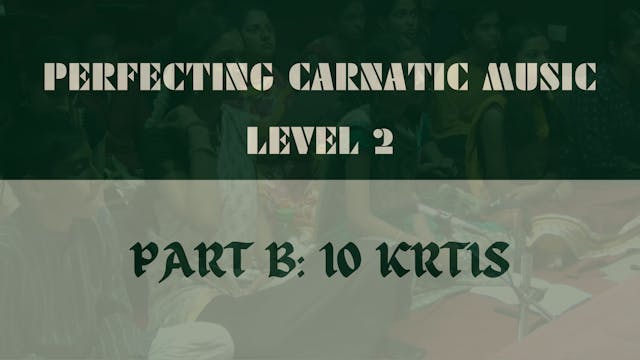 10 videos | Rent $69.99 | Buy $99.99
10 videos | Rent $69.99 | Buy $99.99PERFECTING CARNATIC MUSIC LEVEL 2 - PART B
10 videos | Rent $69.99 | Buy $99.99
This plan gives streaming access to all the lessons from Perfecting Carnatic Music Level 2 syllabus including 10 varnams and 20 kritis.
Compositions in this module are:
1 Gajananayutam - Vegavahini - Adi - Muttuswamy Dikshitar
2 Ra ra rama - Bangala - Adi - Karoor Brothers
3 Mamava raghurama -... -
 10 videos | Rent $69.99 | Buy $99.99
10 videos | Rent $69.99 | Buy $99.99PERFECTING CARNATIC MUSIC LEVEL 2 - PART C
10 videos | Rent $69.99 | Buy $99.99
This plan gives streaming access to all the lessons from Perfecting Carnatic Music Level 2 syllabus including 10 varnams and 20 kritis.
Compositions in this module are:
1. Idisamayamura - Chayanata - Adi - Tyagaraja
2. Bhajare Goapalam - Hindolam - Adi - Sadasiva Bramhendra
3. Senapate - Gowla -...
























